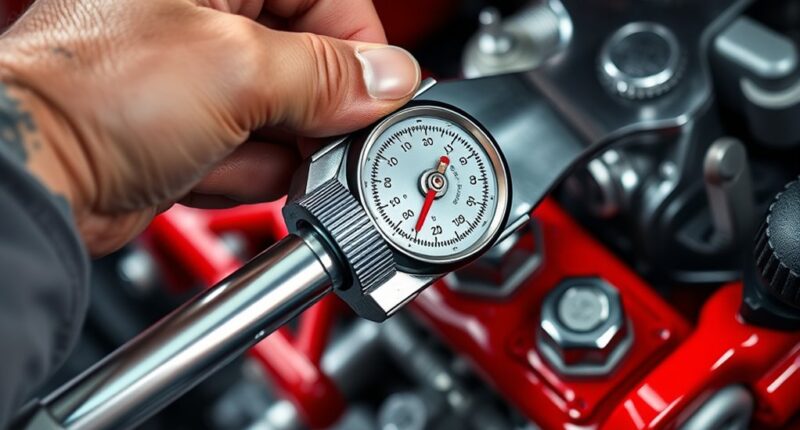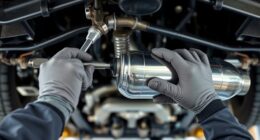To get the most accurate results, always calibrate your torque wrench regularly using certified standards and follow the manufacturer’s guidelines. Use steady, controlled pressure rather than quick jerks and set the desired torque before applying force. Proper technique also means understanding your tool’s history and respecting its calibration. Mastering these secret techniques helps prevent over-tightening or under-tightening, ensuring safe, precise work. Keep going, and you’ll discover even more ways to optimize your torque wrench skills.
Key Takeaways
- Always calibrate your torque wrench regularly using certified standards to ensure accurate readings.
- Use steady, controlled force during application, avoiding sudden or jerky motions.
- Set the correct torque value before tightening and double-check it for precision.
- Store your torque wrench properly, ideally in a protected case, to prevent calibration drift.
- Follow manufacturer guidelines for calibration and maintenance to maintain tool accuracy and longevity.

Using the correct techniques with a torque wrench guarantees you tighten bolts accurately and safely. To do this effectively, understanding the importance of proper calibration procedures is essential. Calibration ensures your torque wrench provides precise readings, preventing under-tightening or over-tightening. Regular calibration is a fundamental step in maintaining your tool’s accuracy, especially if you use it frequently or for critical tasks. By following proper calibration procedures, you can identify and correct any discrepancies, ensuring each torque value you apply is dependable. Many mechanics overlook this step, but it’s what separates amateur work from professional precision. When calibrating, use certified standards and follow manufacturer guidelines to verify the torque wrench’s accuracy. This step should be part of your routine maintenance, especially if you notice inconsistent torque readings or after long periods of storage. Additionally, understanding the history of torque wrenches can motivate you to keep your tools well-maintained, recognizing their importance in safety and precision. Recognizing this evolution helps you appreciate the importance of maintaining your tool properly. It also underscores why calibration procedures are critical—early models lacked the precision of today’s instruments, making calibration even more essential. Knowing the history behind torque wrenches can remind you that your work relies on decades of engineering improvements, and proper care ensures your tool continues to serve you well.
Proper calibration ensures accurate torque readings and maintains your wrench’s reliability over time.
When using a torque wrench, avoid common mistakes like applying force too quickly or using improper technique. Instead, employ a steady, controlled motion, and always set the torque value before applying force. Tap into the history and calibration knowledge to maximize your effectiveness. For example, understanding how calibration procedures are performed on vintage or modern models can inform how you handle your current tool, ensuring it remains accurate over time. Also, knowing the evolution of the torque wrench can motivate you to keep it well-maintained, recognizing its importance in safety and precision. In essence, mastering the correct techniques with a torque wrench involves more than just turning a handle. It’s about respecting the history, performing regular calibration procedures, and applying steady, deliberate force. These practices guarantee that each bolt is tightened to exact specifications, protecting your work and ensuring safety. Taking the time to learn and implement these methods elevates your craftsmanship and keeps your tools functioning at peak performance.
Frequently Asked Questions
What Are the Signs of a Faulty Torque Wrench?
You want to know the signs of a faulty torque wrench. If you notice calibration issues or inconsistent, inaccurate readings, that’s a red flag. A wrench that clicks too early or too late, or one that feels loose or sloppy, might be defective. Regularly check for these signs to make sure your torque wrench gives precise measurements. Ignoring these issues can lead to over-tightening or under-tightening, compromising safety and performance.
How Often Should I Calibrate My Torque Wrench?
You should calibrate your torque wrench at least once a year to maintain peak wrench accuracy. However, if you use it frequently or for critical tasks, consider more frequent calibration, like every six months or after a heavy impact. Following a consistent calibration schedule helps ensure your wrench remains precise, preventing under- or over-tightening. Regular calibration keeps your tools reliable and extends their lifespan, so don’t skip this important maintenance step.
Can Torque Wrench Techniques Vary for Different Vehicle Models?
You might wonder if torque wrench techniques vary for different vehicle models. Yes, they can, since vehicle-specific settings and model-dependent techniques influence how you should use your wrench. Always consult the vehicle’s manual for precise torque specifications and recommended procedures. Adapting your technique guarantees accurate tightening and prevents damage, as different models may require slight adjustments in torque application. Following these guidelines helps maintain vehicle safety and performance.
Are There Safety Tips for Using a Torque Wrench Correctly?
To use a torque wrench safely, always guarantee you have a proper grip to maintain control and prevent slipping. Before tightening, double-check the torque setting to match the manufacturer’s specifications. Keep the wrench perpendicular to the bolt to apply even force. Avoid sudden movements, and always release the torque after use. Following these safety tips helps you avoid damage and ensures accurate, safe tightening every time.
What Common Mistakes Should I Avoid When Using a Torque Wrench?
When using a torque wrench, avoid common mistakes like improper grip, which can affect accuracy, and neglecting calibration frequency, leading to incorrect torque readings. Always hold the wrench firmly with a proper grip to guarantee precision. Regularly calibrate your wrench according to the manufacturer’s recommendations, typically after some use or time, to maintain accuracy. These steps help you achieve correct torque and prevent damage or safety issues.
Conclusion
Mastering these secret torque wrench techniques elevates your mechanical skills to legendary status. With precision and confidence, you’ll tighten bolts with the finesse of a seasoned pro—so much so, it’s as if you wield a tool blessed by the automotive gods themselves. Don’t underestimate the power of these hidden tricks; they can turn an ordinary mechanic into a master craftsman. Embrace these secrets, and watch your work reach extraordinary heights you never thought possible.










